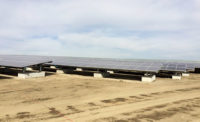The value of the U.S. solar power market soared last year as several states, including New Jersey, significantly boosted installed capacity, according to a recent study by the Solar Energy Industries Association and market research firm GTM Research. Federal, state and, in some cases, local incentive programs and funding initiatives helped raise total year-over-year market value 67%, to $6 billion, the study shows. Market news was healthy nationwide as 16 states each installed more than 10 MW of photovoltaics, up from four in 2007. New Jersey, however, already has surpassed that amount and ranks second nationwide, trailing only California in total PV installations last year (see table).
New Jersey has averaged 15 MW per month of newly installed solar capacity since September 2010, according to the N.J. Board of Public Utilities. The agency credits the growth to incentives including the state's Clean Energy Program, net metering and interconnection regulations, and Solar Renewable Energy Certificates (SREC), which can be sold to assist with project financing.
Incentive programs, especially SREC, have eased the burden for companies seeking to move into solar, says Ed Walters, president of development firm Walters Group, Barnegat, N.J., which will break ground soon on a 6.5-MW solar farm. The state's solar market is growing so fast that Walters Group recently formed Atlantic Solar to design, build and manage solar systems on buildings and properties that Walters Group owns.
The company will start the first phase of construction later this spring on the solar farm, one of the state's largest, Walters says. The Stafford Township farm will occupy 35 acres of landfill space, part of the company's 350-acre business and residential park that already includes some occupied commercial and residential space and one government building. Project completion is set for 2014, Walters says. “We will utilize all the electricity [generated by the farm] at the site,”supplying about 25% to 30% of the park's total electricity needs, he says.
The farm will use a ballasted aluminum racking system of 1,026 solar arrays sitting atop the landfill. The company has put construction of the racking system up for bid to solar-power firms that specialize in racking. “[We are] getting close to awarding that,” Walters says. His company is building the entire solar farm and is in the process of choosing an electrical contractor, he says.
Now under construction, the park still has about 200,000 sq ft of commercial space left to build, Walters says. In mid-April, the company began building 216 apartments and, later this spring, will begin constructing 349 residential homes on the site, he says.
In non-residential work, installations nationwide have been slow to recover from the financial crisis; however, as new incentives have emerged and conditions for financing improved, so has this sector, the SEIA study shows. In New Jersey, non-residential projects that have taken advantage of financing deals include a 697-KW project at Teterboro Airport developed and financed by Sunlight General Capital, a New York City-based solar development and finance firm.
The project, which is set for completion in May, consists of a ballasted system of solar arrays on four hangars operated by aircraft service provider Jet Aviation, says Stacey Hughes, principal at Sunlight General. The firm hired two local firms it has worked with before: energy engineering and project development specialist Eneractive Solutions, Asbury Park, N.J., and solar-power installer Pfister Energy, Paterson, N.J. “We have a handful of partners we work with,” Hughes says. “Solar's really hot in New Jersey,” she says, adding that this makes finding qualified contractors a major challenge. “There are lots of guys running around saying they can do it.”
Sunlight General is financing 100% of the $3.5-million project, Hughes says. Under a power purchase agreement, Jet Aviation will lease the equipment and buy electricity from Sunlight General at a predefined fixed rate that is lower than utility rates, Hughes says. “We benefit from the SREC, which is one of the attributes of running solar in New Jersey,” she says.
Meanwhile, 10 companies, including New Jersey's PSE&G utility, accounted for two-thirds of the nation's solar installations last year, PSE&G says. The utility's current construction projects include a 4.4-MW solar farm in Hamilton, one of four planned ground-mounted solar farms. The project, part of the utility's $750-million plan to increase solar energy generation, comprises 15,750 solar panels covering 15.75 acres of the utility's property. Solar integrator and developer American Capital Energy, North Chelmsford, Mass., is deploying the project.=
| State | Photovoltaics (MWdc) | Concentrating Solar Power (MWac) |
|---|---|---|
| California | 258.9 | |
| New Jersey | 137.1 | |
| Nevada | 61.4 | |
| Arizona | 54 | 1.5 |
| Colorado | 53.6 | 1 |
| Pennsylvania | 46.8 | |
| New Mexico | 42.8 | |
| Florida | 35.2 | 75 |
| North Carolina | 30.7 | |
| Texas | 22.6 | |
| Rest of U.S. | 135.2 | |
| Total | 878.3 | 77.5 |
| *Top-10 states installing solar power in 2010. Source: Solar Energy Industries Association and GTM Research. | ||

